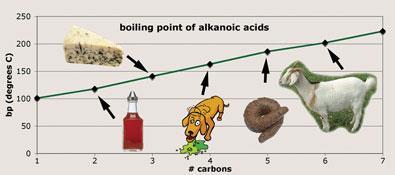Dylan Stiles raises a stink
For the past few days, one of my coworkers has been polluting the atmosphere of my lab with benzyl mercaptan. This delightful chemical smells like rotten burning rubber, if such a thing could exist. Benzyl mercaptan is the first thing I smell when I get into lab each morning, and it’s far better at waking me up than a cup of coffee. I understand that my colleague is using this reagent out of necessity, so I don’t complain. But after explaining the situation to a non-chemist friend, I’ve come to realize there are very few professions where you could vandalise the workplace with noxious-smelling materials and get away with it. And what a range of compounds there are to choose from.
The broadest and most familiar class of foul-smelling chemicals is the thiols, also known as mercaptans. From methyl to butyl, simple alkyl thiols smell like an omelette made out of skunk, garlic, and rotting eggs. They’re bad, but evaporate quickly and don’t linger for long.
The sodium salt of ethanethiol, sodium ethanethiolate, is an oddball that deserves mention. It’s a useful reagent because of its strong nucleophilicity, and as a salt you’d think it would be non-volatile. In reality, the sodium ethanethiolate experience is a visceral one: it’s a karate kick that hits you deep down and makes your nose burn. It’s so potent that even if you dispense it into a vial in the hood, the act of walking the capped vial over to the balance will stink up the lab for quite some time.
I have also found that the odour will stay on you, long after you leave the lab. Unless you go home and immediately shower and change your clothes, this can have unforeseen repercussions on your social activities.
From thiols, moving down a notch on the period table gets you to selenides, the analogous selenium compounds that smell even worse. As a na?ve first-year, I had a close encounter with the granddaddy of them all, hydrogen selenide. After running a reaction with selenium oxide, my glassware was encrusted with a black residue that wouldn’t budge. Figuring that concentrated sulfuric acid might loosen it up, I poured a liberal amount into the flask. Instantly a cloud of gas shot up, no doubt containing the dreaded H2Se. Thankfully this was in the confines of a fume hood, but it was enough to leave a lasting impression. It was horrendous.
The alkyl diamines, namely putrescine (1,4-diaminobutane) and cadaverine (1,5-diaminopentane) are self-describing and need no introduction. I’ve sniffed them both, and in spite of their names I have to say I was not impressed. They’re not volatile enough to create the overwhelming olfactory sensation worthy of such commanding titles.
The final class of chemicals I’ll mention holds a unique place in the pantheon of disagreeable odours. My interest in alkanoic acids was piqued by an unusual entry in the Merck Index. There, hexanoic acid (caproic acid) is described as an ’oily liquid, bp 205 ?C, characteristic goat-like odour’. The Merck Index is renowned for its accuracy, and the goat reference intrigued me. So much that I ran, not walked, to the stockroom to grab a bottle and find out for myself.

Having assumed the wafting position, I inhaled a bouquet unlike any other I have known. While I can’t say it’s exclusive to goats, hexanoic acid has an ineffable barnyard animal quality. With my eyes closed, I was metaphysically transported back to the petting zoo.
What I find peculiar about organic acid smells is the trend, or lack thereof, as you go from formic acid and start lengthening the chain. I did the experiment and spent about 20 minutes digging through various cabinets to systematically smell them all. Starting with formic acid, which doesn’t provide an odour so much as a sensation of pain, I went all the way up to heptanoic acid, which is so non-volatile that it gives little more than a faint malodorous impression. The results of everything in between are summarised in the figure below.
Science may never be able to explain why extending propionic acid by three carbons changes the smell from cheese to goats. Some questions may be better left unanswered.












No comments yet